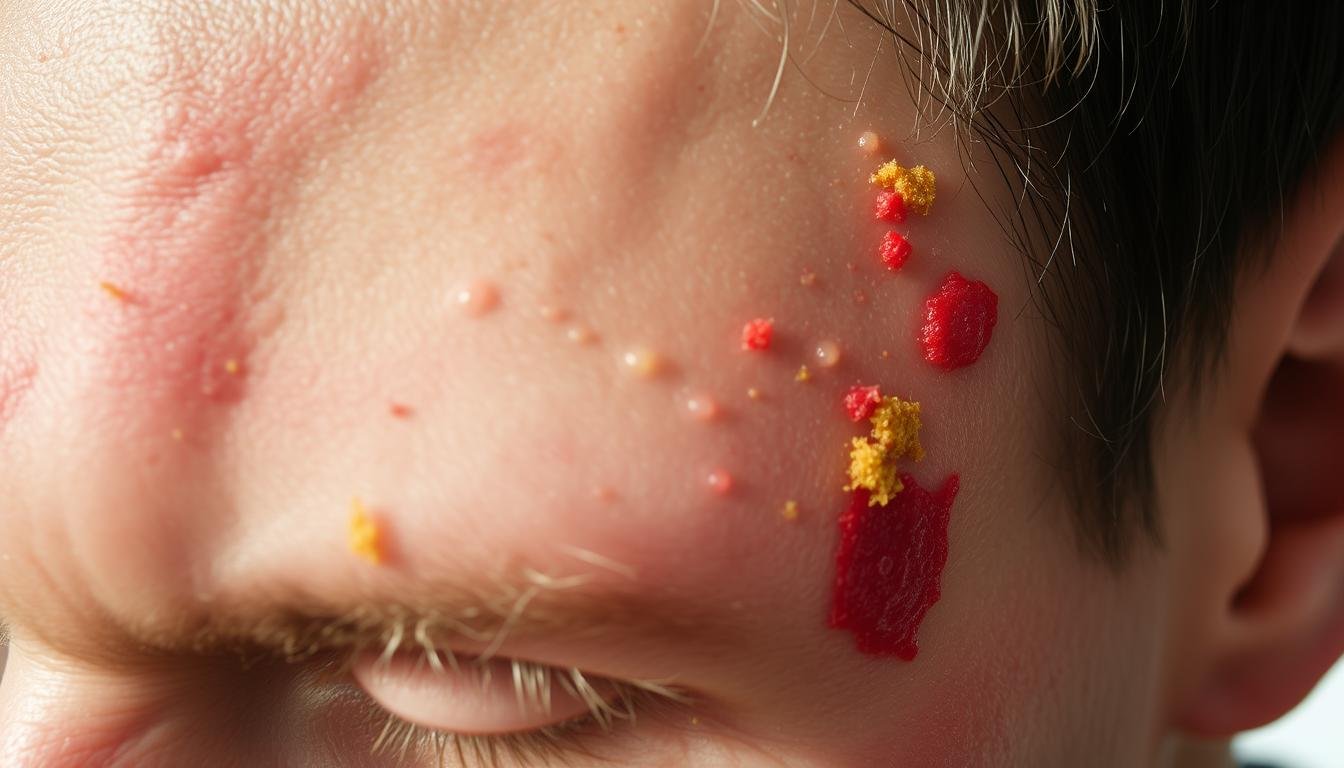What is Seborrheic Dermatitis, and How is it Treated?
Did you know that seborrheic dermatitis affects a staggering 3-10% of the population, with the condition being more common in infants and adults aged 30-60? This chronic skin condition, characterized by flaky skin, redness, and persistent itching, can be a frustrating experience for those affected. While it may not be considered severe, seborrheic dermatitis can significantly impact one’s quality of life and requires ongoing management.
Seborrheic dermatitis is a form of eczema that primarily affects the scalp and other oily areas of the body, including the face, sides of the nose, eyebrows, ears, eyelids, and chest. The condition can present differently depending on an individual’s skin tone, with oily patches and yellow or white scales appearing darker or lighter in people with brown or Black skin, and redder in those with white skin. Symptoms can range from flaking skin on various body parts to greasy skin covered with flaky scales, accompanied by an itchy rash.
Key Takeaways
- Seborrheic dermatitis is a common form of eczema that affects 3-10% of the population, more commonly in infants and adults aged 30-60.
- The condition is characterized by flaky skin, redness, and persistent itching, primarily affecting the scalp and other oily areas of the body.
- Seborrheic dermatitis symptoms can vary in appearance based on an individual’s skin tone, including oily patches, yellow or white scales, and redness.
- While not severe, seborrheic dermatitis can be a chronic and frustrating condition that requires ongoing management and treatment.
- Effective treatment options include medicated shampoos, creams, lotions, and even oral antifungal medications in severe cases.
Definition of Seborrheic Dermatitis
Seborrheic dermatitis is a common skin condition that causes scaly, flaky, and sometimes itchy patches to appear on the scalp, face, and other oily areas of the body. It is characterized by red, inflamed skin with white or yellow crusty scales that can be stubborn and persistent.
Overview of Symptoms
The primary symptoms of seborrheic dermatitis include:
- Flaky, scaly skin
- Greasy or oily patches with white or yellow scales
- Itchiness or irritation
- Redness and inflammation
Common Affected Areas
Seborrheic dermatitis typically affects the areas of the body with the most sebaceous (oil) glands, such as the:
- Scalp (known as dandruff or cradle cap in infants)
- Face, especially the sides of the nose, eyebrows, and forehead
- Ears and eyelids
- Chest and upper back
The appearance of seborrheic dermatitis can vary depending on skin tone. On lighter skin, it may appear as red, scaly patches, while on darker skin, the affected areas may appear drier, flakier, or even slightly discolored.

“Seborrheic dermatitis is a common, chronic condition that can significantly impact a person’s quality of life. It’s important to understand the symptoms and affected areas to seek appropriate treatment.”
Causes of Seborrheic Dermatitis
The exact cause of seborrheic dermatitis remains unclear, but it is believed to involve a complex interplay of genetic, hormonal, and environmental factors. While the condition is not contagious, certain triggers can exacerbate the symptoms and lead to flare-ups.
Genetic Predisposition
Research indicates that individuals with a family history of seborrheic dermatitis are more likely to develop the condition. This suggests a genetic component that may make certain people more susceptible to the inflammatory response associated with the disease.
Hormonal Factors
Hormonal changes can also play a role in the development of seborrheic dermatitis. For instance, the condition is commonly seen in infants, where hormonal fluctuations during the first few months of life can trigger the onset of the condition, also known as “cradle cap.”
Environmental Triggers
Environmental factors, such as changes in weather, stress, and exposure to harsh chemicals, can also contribute to the development and exacerbation of seborrheic dermatitis. The condition is often observed to worsen during the winter months or in dry, cold climates.
Additionally, individuals with compromised immune systems, neurological conditions, or certain medical treatments may be more susceptible to seborrheic dermatitis due to the inflammatory response it provokes.

“Understanding the underlying causes of seborrheic dermatitis is crucial in effectively managing and treating this chronic skin condition.”
Risk Factors for Developing Seborrheic Dermatitis
Seborrheic dermatitis is a common skin condition that can affect individuals of all ages, though certain risk factors make some people more susceptible to developing it. Understanding these risk factors is crucial for proper management and prevention of this stubborn skin disorder.
Age and Gender
Seborrheic dermatitis primarily affects newborns, known as “cradle cap,” as well as adults between the ages of 30 and 60. The condition is more prevalent in men than women, likely due to increased sebum production and oilier skin.
Pre-existing Skin Conditions
Individuals with certain pre-existing skin conditions, such as Psoriasis, acne, rosacea, and even HIV infection, are at a higher risk of developing seborrheic dermatitis. These underlying conditions can contribute to the development or exacerbation of the skin disorder.
Immune System Weakness
A weakened immune system can also increase the risk of seborrheic dermatitis. Conditions like Parkinson’s disease, depression, and organ transplant recipients are associated with a higher susceptibility to the condition, as the body’s natural defense mechanisms may be compromised.
Certain medications, such as psoralen, interferon, and lithium, have also been known to trigger the onset of seborrheic dermatitis in some individuals.
Understanding these risk factors can help individuals recognize the potential for developing seborrheic dermatitis and take proactive steps to manage the condition, whether through lifestyle changes, proper skin care, or seeking medical treatment when necessary.

Differentiating Seborrheic Dermatitis from Other Skin Conditions
Seborrheic dermatitis can often be mistaken for other common skin conditions, such as Psoriasis, eczema, and fungal infections. Understanding the key differences is crucial for accurate diagnosis and effective treatment. Let’s explore how to distinguish seborrheic dermatitis from these similar skin disorders.
Psoriasis
While both seborrheic dermatitis and Psoriasis can cause scaly, red patches on the skin, there are notable differences in their appearance and distribution. Psoriasis typically presents with well-defined, thick, silvery-white plaques, often on the elbows, knees, and scalp. In contrast, seborrheic dermatitis usually results in more yellowish, greasy scales that tend to appear on the face, chest, and upper back.
Eczema
Eczema, or atopic dermatitis, is characterized by intense itching, dryness, and inflammation, primarily affecting the flexural areas of the body, such as the inside of the elbows and behind the knees. Seborrheic dermatitis, on the other hand, typically occurs on the more oil-rich regions, like the Scalp, face, and upper chest, and may not itch as intensely as eczema.
Fungal Infections
Both seborrheic dermatitis and certain fungal infections, such as tinea versicolor, can cause scaly, discolored patches on the skin. However, fungal infections often have a more distinct, circular pattern, while seborrheic dermatitis tends to be more diffuse and less well-defined. Additionally, fungal infections may require specific antifungal treatments, whereas seborrheic dermatitis may respond better to anti-inflammatory or antifungal therapies targeting the underlying Malassezia yeast overgrowth.
Accurately differentiating seborrheic dermatitis from these other skin conditions is essential for developing an effective treatment plan. A healthcare professional, such as a dermatologist, can perform a comprehensive examination and, if necessary, order additional tests to ensure an accurate diagnosis and guide the most appropriate management strategy.
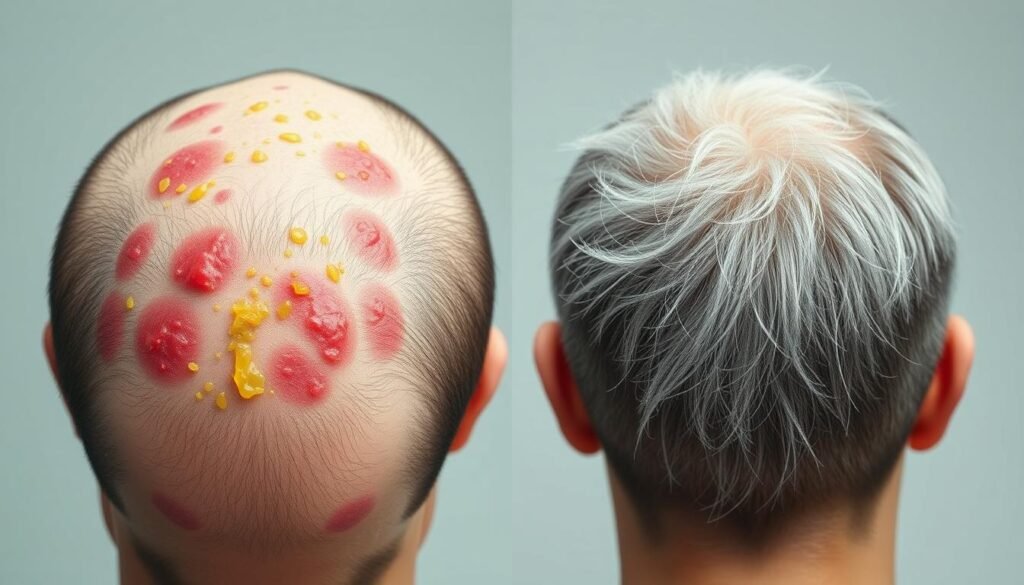
Diagnosis of Seborrheic Dermatitis
Diagnosing seborrheic dermatitis typically involves a thorough medical history review and physical examination by a healthcare provider. They will look for the characteristic symptoms of this skin condition, such as scaly, red patches in oily areas of the body, including the Scalp, face, upper chest, and back.
Medical History Review
During the medical history review, the healthcare provider will ask about the patient’s symptoms, including the onset, duration, and severity of the rash. They may also inquire about any underlying health conditions, medications, or environmental factors that could be contributing to the skin irritation.
Physical Examination
The physical examination is crucial in diagnosing seborrheic dermatitis. The healthcare provider will carefully inspect the affected areas, noting the appearance and distribution of the rash. They may also perform a gentle scraping of the skin to collect a sample for further analysis.
Possible Lab Tests
- In some cases, the healthcare provider may recommend additional lab tests to rule out other skin conditions, such as:
- Skin biopsy: A small sample of skin may be taken for microscopic examination to confirm the diagnosis.
- Fungal culture: A skin sample may be tested for the presence of fungal organisms that could be causing the rash.
- These tests are usually only necessary if the diagnosis is unclear or if the condition is not responding to initial treatment.
The pattern and appearance of the rash, along with its response to treatment, help confirm the diagnosis of seborrheic dermatitis. By combining the medical history, physical examination, and, if necessary, lab tests, healthcare providers can accurately diagnose and develop an effective treatment plan for this common skin condition.
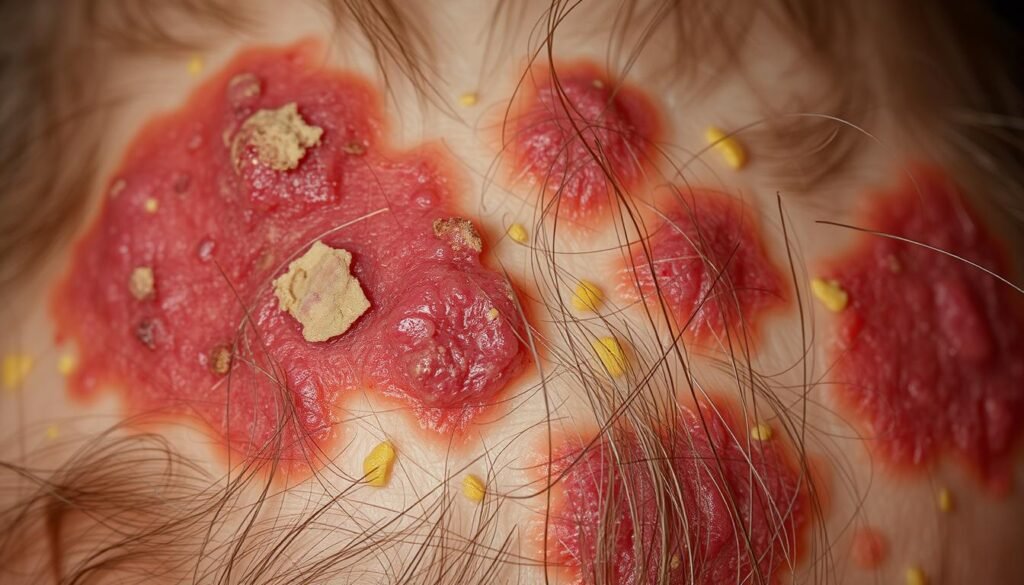
Treatment Options for Seborrheic Dermatitis
Managing seborrheic dermatitis often involves a combination of over-the-counter treatments, prescription medications, and home remedies. The primary goal is to reduce the visible signs, itching, and redness associated with this common skin condition.
Over-the-Counter Treatments
Many people find relief using over-the-counter dandruff shampoos containing active ingredients like selenium sulfide, zinc pyrithione, or coal tar. These shampoos can help control the excess oil and scale on the Scalp. In a clinical trial, ciclopirox, a prescription shampoo, resulted in 58% and 26% of patients having little to no seborrheic dermatitis after just 4 weeks of use.
Prescription Medications
For more stubborn cases, healthcare providers may prescribe topical antifungal creams, corticosteroids, or calcineurin inhibitors. In a study, 68.3% of patients treated with roflumilast foam, a medication for seborrheic dermatitis, saw clear or almost clear skin within 8 weeks. Propylene glycol, applied once daily for 3 weeks, has also been found to reduce scale and yeast on the skin, helping alleviate seborrheic dermatitis symptoms.
Home Remedies
In addition to medical treatments, certain home remedies and lifestyle changes can be beneficial for managing seborrheic dermatitis. Some individuals report improvement with yeast elimination diets, omega-3 fatty acid supplements, or topical applications of tea tree oil, aloe vera, or avocado oil. Cognitive Behavioral Therapy may also help address the psychological impacts of this condition.
Effective treatment for seborrheic dermatitis often requires a multi-pronged approach, with patients working closely with their healthcare providers to find the right combination of therapies. Consistent management is key to preventing flare-ups and maintaining healthy, comfortable skin.

Role of Shampoos in Treatment
Managing Scalp seborrheic dermatitis often requires the strategic use of specialized shampoos. These shampoos can help control the symptoms and prevent flare-ups of this persistent skin condition.
Anti-fungal Shampoos
Anti-fungal shampoos containing ingredients like ketoconazole or ciclopirox are effective for long-term management of seborrheic dermatitis. These shampoos target the Malassezia yeast that can trigger the condition, helping to reduce inflammation and scale buildup on the Scalp.
Medicated Shampoos
For moderate to severe cases of seborrheic dermatitis, healthcare providers may prescribe medicated shampoos containing ingredients like betamethasone valerate or fluocinolone. These shampoos combine antifungal and anti-inflammatory properties to provide more comprehensive relief.
Infrequent Hair Washing
Contrary to popular belief, frequent hair washing is not necessarily beneficial for those with seborrheic dermatitis. In fact, infrequent washing with a medicated shampoo, as directed by a healthcare provider, can help maintain the skin’s natural protective barrier and prevent further irritation.
By incorporating the right shampoos into their treatment regimen, individuals with seborrheic dermatitis can better manage their symptoms and reduce the risk of flare-ups. Regular use of these specialized products, combined with other recommended therapies, can be an essential part of effectively controlling this chronic skin condition.
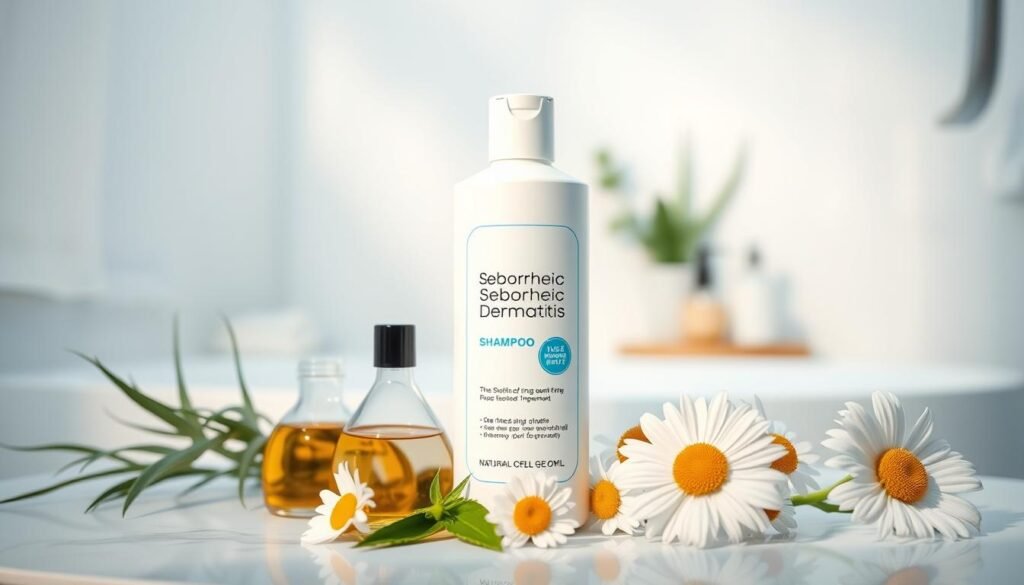
Lifestyle Changes to Manage Seborrheic Dermatitis
If you’re struggling with seborrheic dermatitis, incorporating lifestyle changes can make a significant difference in managing your symptoms. From adjusting your diet to adopting stress-reducing techniques, these simple steps can provide relief and prevent future flare-ups.
Diet and Nutrition
While the link between diet and seborrheic dermatitis is not fully understood, some studies suggest that dietary changes may help alleviate the condition. Incorporating anti-inflammatory foods like omega-3-rich fish, avocados, and leafy greens may be beneficial. Avoiding processed foods, refined carbohydrates, and foods high in sugar could also help manage seborrheic dermatitis natural remedies.
Stress Management Techniques
- Practice stress-reducing activities like yoga, meditation, or deep breathing exercises.
- Engage in regular physical exercise, which can help alleviate stress and improve overall skin health.
- Prioritize getting enough quality sleep, as sleep deprivation can exacerbate seborrheic dermatitis.
Skin Care Routine Adjustments
Developing a gentle, seborrheic dermatitis natural remedies skin care routine can make a significant difference in managing seborrheic dermatitis. Consider using cleansers and moisturizers containing ingredients like zinc, which can help soothe and calm the skin. Avoid products with harsh chemicals or fragrances that may further irritate the affected areas.
By making these lifestyle changes, you can take an active role in managing your seborrheic dermatitis and alleviate the discomfort associated with this chronic condition.

“Incorporating simple lifestyle adjustments can be a game-changer in managing seborrheic dermatitis.”
Long-term Management Strategies
Effectively managing seborrheic dermatitis often requires ongoing maintenance treatments, even during periods of remission. Developing a personalized care plan with a dermatologist is key to achieving long-term control over this recurrent skin condition.
Ongoing Maintenance Treatments
Regular use of medicated shampoos or topical treatments can help keep seborrheic dermatitis under control. Antifungal shampoos containing ketoconazole, ciclopirox, or selenium sulfide are commonly prescribed to manage scalp flare-ups. For non-scalp areas, topical antifungals, corticosteroids, or calcineurin inhibitors may be recommended.
Importance of Regular Skin Assessment
Conducting regular skin assessments, either through self-examination or visits with a healthcare provider, is crucial for identifying and addressing seborrheic dermatitis flare-ups early. This allows for prompt treatment and helps prevent the condition from worsening over time.
According to recent studies, seborrheic dermatitis affects approximately 6 million people in the United States, with direct and indirect medical costs reaching around $230 million per year. Maintaining a personalized treatment plan and vigilantly monitoring skin health can go a long way in managing this chronic condition.

“Developing a personalized care plan with a dermatologist can lead to better long-term control of seborrheic dermatitis.”
Potential Complications of Seborrheic Dermatitis
While seborrheic dermatitis is not typically a severe skin condition, it can lead to several potential complications if left untreated or managed improperly. Understanding these complications is crucial for effectively addressing the overall impact of this chronic skin disorder.
Secondary Infections
The scaly, inflamed skin caused by seborrheic dermatitis can disrupt the skin’s natural barrier, making it more susceptible to secondary bacterial infections. These infections can exacerbate symptoms, leading to increased redness, swelling, and discomfort. Proper skin care and the use of medicated shampoos or topical treatments are essential to prevent such complications.
Psychological Effects
The visible nature of seborrheic dermatitis, especially when it affects the face, can have a significant impact on an individual’s self-esteem and overall quality of life. The condition may lead to feelings of self-consciousness, social anxiety, and even depression. Addressing the psychological aspects of living with seborrheic dermatitis symptoms is crucial for a comprehensive approach to managing this skin disorder.
To mitigate the potential complications of seborrheic dermatitis symptoms, it is essential to follow a consistent skincare routine, use medicated treatments as directed, and seek professional help if symptoms persist or worsen. Additionally, incorporating stress management techniques and seeking support from healthcare providers or mental health professionals can help address the emotional and psychological aspects of this condition.
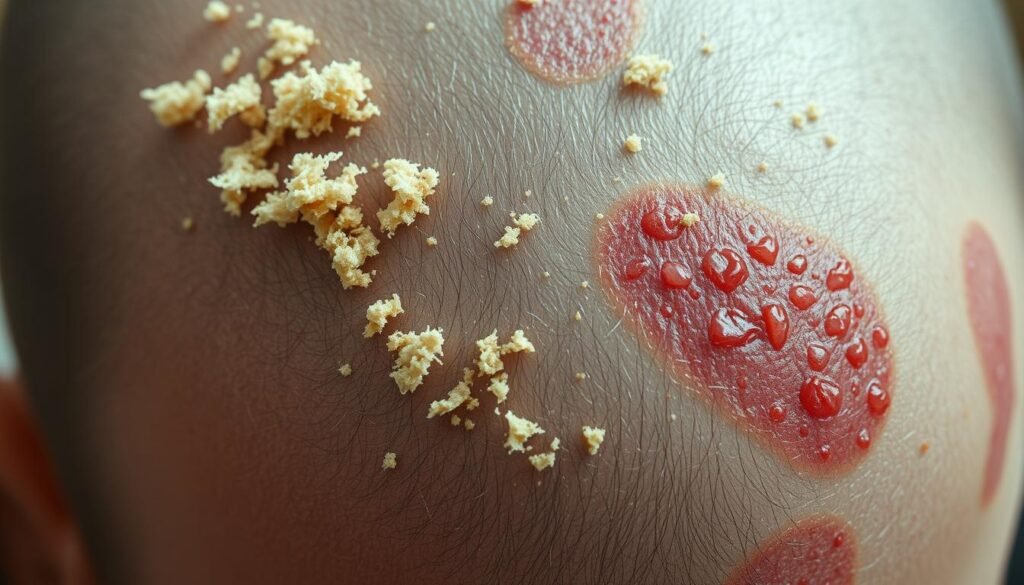
“Addressing both the physical and emotional aspects of living with seborrheic dermatitis is crucial for improving overall well-being and quality of life.”
When to Seek Professional Help
While many cases of seborrheic dermatitis can be managed with self-care and over-the-counter treatments, individuals should seek professional medical assistance if symptoms persist for more than two weeks or worsen despite their efforts. Persistent or worsening symptoms may indicate the need for specialized care from a dermatologist.
Signs of Severity
Individuals should consult a healthcare provider if they experience widespread rashes, severe itching, or signs of secondary infection, such as oozing or crusting lesions. These signs may suggest the condition requires more advanced treatment approaches.
Referral to a Dermatologist
A dermatologist can provide a thorough evaluation and recommend appropriate treatments for difficult-to-manage cases of seborrheic dermatitis. They may adjust existing treatment regimens or suggest additional therapies, such as prescription medications or phototherapy. Regular follow-ups with a dermatologist can help ensure the condition remains under control and address any new concerns that arise.
FAQ
What is seborrheic dermatitis?
Seborrheic dermatitis is a common form of eczema that affects the scalp and other oily areas of the body. It is characterized by flaky skin, redness, and itching. The condition is chronic, with patterns of flaring and clearing.
What are the symptoms of seborrheic dermatitis?
Seborrheic dermatitis manifests as scaly patches, inflamed skin, and stubborn dandruff. Symptoms include flaking skin, greasy patches with white or yellow scales, itchiness, and redness. It primarily affects oily areas like the scalp, face, sides of the nose, eyebrows, ears, eyelids, and chest.
what causes seborrheic dermatitis?
The exact cause of seborrheic dermatitis is unclear but likely involves a combination of genetic and environmental factors. It’s often triggered by an inflammatory reaction to excess Malassezia yeast on the skin. Hormonal changes, stress, and certain medical conditions can also increase the risk.
Who is at risk of developing seborrheic dermatitis?
Risk factors include age (infants and adults 30-60), male gender, and certain medical conditions like psoriasis, HIV, acne, rosacea, Parkinson’s disease, epilepsy, and depression. Stress, hormonal changes, and immune system weakness can also increase susceptibility.
How is seborrheic dermatitis different from other skin conditions?
Seborrheic dermatitis differs from psoriasis in its location and appearance. Unlike eczema, it typically affects oily areas. While similar to dandruff, seborrheic dermatitis is more severe and widespread. Fungal infections may mimic its symptoms but require different treatments.
How is seborrheic dermatitis diagnosed?
Diagnosis typically involves a thorough medical history review and physical examination. Healthcare providers look for characteristic symptoms like scaly patches and redness in oily areas. In some cases, skin scrapings or biopsies may be performed to rule out other conditions.
How is seborrheic dermatitis treated?
Treatment aims to reduce visible signs, itching, and redness. Over-the-counter options include dandruff shampoos containing selenium, zinc pyrithione, or coal tar. Prescription treatments may include antifungal creams, corticosteroids, or calcineurin inhibitors. Home remedies and lifestyle changes can also help manage symptoms.
What is the role of shampoos in treating seborrheic dermatitis?
Shampoos play a crucial role in managing scalp seborrheic dermatitis. Anti-fungal shampoos containing ketoconazole or ciclopirox are effective for long-term control. Medicated shampoos with ingredients like betamethasone valerate or fluocinolone may be prescribed for moderate to severe cases.
How can lifestyle changes help manage seborrheic dermatitis?
Lifestyle changes can significantly impact seborrheic dermatitis management. Stress reduction, a gentle skincare routine, dietary adjustments, regular exercise, and adequate sleep can all contribute to overall skin health and symptom management.
How can seborrheic dermatitis be managed long-term?
Long-term management of seborrheic dermatitis often requires ongoing maintenance treatments, regular skin assessments, and a personalized care plan developed with a dermatologist. This can help ensure the condition remains under control and address any new concerns promptly.
When should someone seek professional help for seborrheic dermatitis?
Professional help should be sought if symptoms persist for more than two weeks despite self-care efforts. Signs of severity include widespread rash, severe itching, or signs of infection. A dermatologist can provide specialized care for difficult-to-manage cases.
